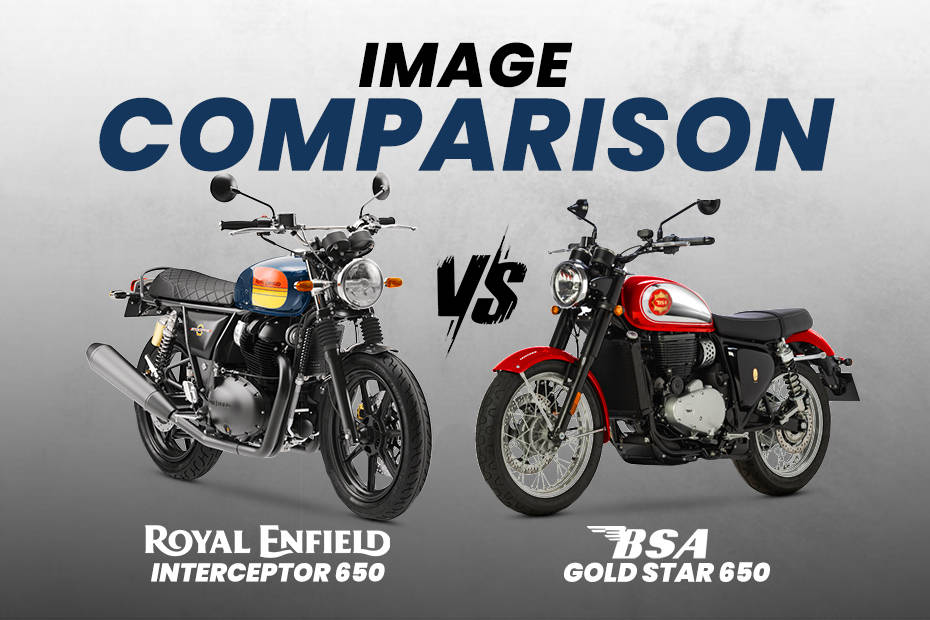BSA Gold Star 650 vs Royal Enfield Interceptor 650: Image Comparison
Modified On Jun 25, 2024 04:41 PM By Govind for Royal Enfield Interceptor 650
- 2173 Views
- Write a comment
The BSA Gold Star will be coming to India this independence day and will go up against the Royal Enfield Interceptor 650. Which retro British Style roadster should you go for?

BSA had announced that they will be launching the BSA Gold Star in India on Independence Day, August 15. Once launched, the Gold Star will go up against the Royal Enfield Interceptor 650. Here’s our detailed comparison of the two retro British roadsters, in images.
Design
When it comes to design, both motorcycles do a good job representing modern renditions of the OG BSA Gold Star and the Royal Enfield Interceptor. Both feature that iconic retro British styling with a round headlight and teardrop shaped fuel tank.


When compared with each other, it is hard to say which one looks better, as looks are subjective. However, there is one thing that has to be said, the BSA does look a bit more premium thanks to the chrome detailing and the badging on its tank.
Engine
The BSA Gold Star is powered by a 652cc, liquid-cooled single-cylinder engine that produces 45.6PS and 55Nm, paired to a 5-speed gearbox. Whereas the Royal Enfield Interceptor 650 is powered by a 648cc air/oil-cooled parallel-twin engine that outputs 47PS and 52Nm, and is mated to a 6-speed gearbox.

The riding experience both bikes will offer is going to be very different. The Gold Star being a big single could feel a bit more torquey, which will also come earlier. It is also likely to offer that ‘thump,’ which big singles are known for, similar to what the Royal Enfield Classic 500 once did. The Interceptor is powered by a twin-cylinder engine, which translates into a more refined riding experience.
Underpinnings
The BSA Gold Star is built on a dual cradle frame and is suspended on a 41mm telescopic fork and 5-step preload-adjustable twin rear shock absorbers. It rolls on an 18-inch front and 17-inch rear spoke wheel with 100-section front and 130-section rear tube tyres. Braking duties are handled by a 320mm floating disc at the front and a 255mm disc at the rear. Its kerb weight is 213kg and has a seat height of 780mm.


Interceptor 650 features a similar dual cradle frame. It is suspended on a 41mm telescopic fork and twin gas-charged shock absorbers. The bike rolls on 18-inch alloy/spoke wheels depending on the variant. Braking duties are handled by 320mm front and a 240mm rear disc with dual-channel ABS. The Interceptor has a kerb weight of 218kg and the seat height is 804mm.
Features
Both bikes are quite barebones when it comes to features, keeping in line with the retro character of the machines, and come equipped with twin-pod instrument consoles. Both consoles feature a similar setup, with a speedometer on the left and a tachometer on the right.

The Gold Star’s console features digital insets on both the pods, with the one on the left showing odometer and trip meter readings and the one on the right showing fuel levels. BSA has mounted another small pod on top of the headlight for telltale lights like neutral, and check engine lights. Other features include a side-stand sensor and an anti-theft engine immobiliser device, giving the bike a bit of extra safety.
The Interceptor's console has a digital inset on the left, which displays fuel levels along with the odometer and trip meter readouts. The basic telltale lights are integrated into the right side pod.
Which Bike Should You Choose?
To wait for the Gold Star or just get the Interceptor 650 depends on what you are looking for. There is no argument about the fact that both bikes look good.

If you want to experience that single cylinder riding experience with the ‘thump’ then the Gold Star makes sense, it also has a lot of additional safety features to offer which the Interceptor 650 lacks.

But one cannot easily discount the Interceptor 650 which has a few unique selling points. The first of which is the tried and tested 650cc twin cylinder engine that offers reliable performance and is quite exciting in its own way. Second is the large Royal Enfield service network which ensures that getting the bike serviced is easy and parts are not too expensive. So far Classic legends hasn’t built a network as large as Royal Enfield’s.
